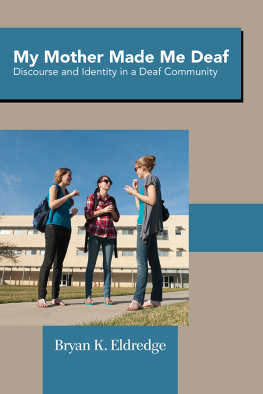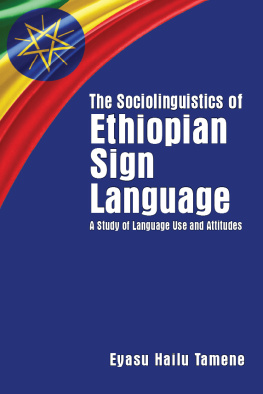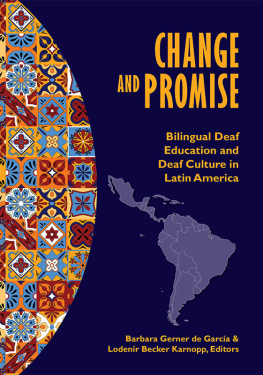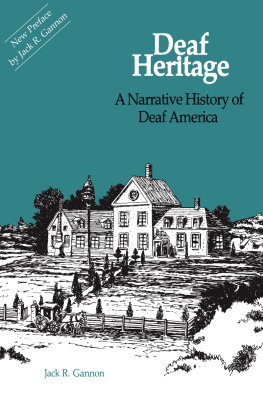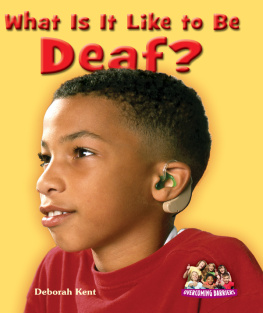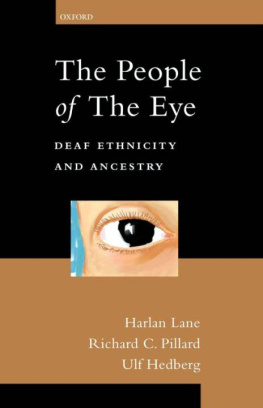The Language of Light

Published with assistance from the foundation established in memory of
James Wesley Cooper of the Class of 1865, Yale College.
Copyright 2017 by Gerald Shea.
All rights reserved. This book may not be reproduced, in whole or in part,
including illustrations, in any form (beyond that copying permitted by
Sections 107 and 108 of the U.S. Copyright Law and except by reviewers
for the public press), without written permission from the publishers.
Pages 711, 8081, 162, 172175, 201, 202203, 207, and 209 contain text
reproduced from Song Without Words: Discovering My Deafness Halfway
through Life by Gerald Shea, copyright 2013. Reprinted by permission
of Da Capo Press, an imprint of Perseus Books, LLC, a subsidiary of
Hachette Book Group, Inc.
Yale University Press books may be purchased in quantity for educational,
business, or promotional use. For information, please e-mail
(U.K. office).
Set in Gotham and Adobe Garamond types by IDS Infotech Ltd.
Printed in the United States of America.
ISBN 978-0-300-21543-4 (hardcover : alk. paper)
Library of Congress Control Number: 2017931104
A catalogue record for this book is available from the British Library.
This paper meets the requirements of ANSI/NISO Z39.48-1992
(Permanence of Paper).
10 9 8 7 6 5 4 3 2 1
For Claire, Pnlope, Sebastian, and Alexander
The blind are more intelligent than deaf-mutes.
Aristotle, 350 B.C.E.
Never... let the mute use sign language.
Juan Pablo Bonet, 1620
It is no longer possible to doubt whether a deaf man may be perfectly restored to society. With the benefit of instruction, he is neither deaf to those who know how to write, nor mute to those who can read. All the treasures of the human mind are placed at his disposal; he no longer has anything to envy in other men.
Auguste Bbian, 1817
We do not speak, it is true; but still do you think us unable to express ourselves as well with our eyes, our hands, our smiles, our lips? Our most beautiful discourse is at the tips of our fingers, and our language is rich in secret beauties that you who speak will never know. And have we not our own art of Phoenicia to paint the words that speak into our eyes?
Ferdinand Berthier, 1840
You, Sir, who have the rare talent of being at once mute and eloquent, please tell your friends... that in my eyes the accession of the deaf to civic and intellectual life must be counted among the most magnificent and decisive accomplishments in the history of the progress of humanity.
Victor Hugo (to Berthier), 1850
The practice of... sign language... makes deaf-mutes associate together in adult life, and... thus causes the[ir] intermarriage... and the propagation of their physical defect... Segregation during education has not only favored the tendency towards the formation of a race of deaf-mutes, but has led to the evolution of a special language adapted for the use of such a racethe sign-language of the deaf and dumb.
Alexander Graham Bell, 1887
[T]he work [we have] so far accomplished seems to us to substantiate the claim that the communicative activity of persons using [sign] language is truly linguistic and susceptible of micro-linguistic analysis of the most rigorous kind.
William C. Stokoe, 1960
Technology has decisively shifted the balance of power in the oralists favor... The signing deaf community will last another generation or two, but already it is seeing the signs on the wall and setting its house in order. Going gentle, with diminishing rage.
Michael Chorost, 2006
Contents
Preface
This book is an intellectual history, an exploration of certain ideas about language. Everyone needsit is a universal needto be able to use his or her own tongue, the one he or she is at home in. The attribute that distinguishes us from other creatures is our capacity, through language, to express and explain our ideas and to receive and understand those of others. Language gives us, all of us, whether Deaf or hearing, a modern soul in the age of science, and underpins our rights as individuals. Take that away, and you have nothing.
I have been partially deaf since the age of six due to a childhood illness. The words that others speak to me are not my language: lyricals are the language I perceive and interpret, as I write in my earlier book, Song Without Words. They are what I call the transitional words, wrong words, and often non-words that, in lieu of those actually spoken, register in the minds of the partially deaf. Many of the hearing cells in our inner ears are dead or moribund, and the surviving cells deliver incomplete signals to the brain. Thus when others speak we hear only the contours of an elusive language to which, with our imperfect ears, and eyes that desperately search the lips of others, we endeavor to give meaning.
Children who are born Deaf, however, hear virtually nothing at all. They are also unable to speak because their ears cannot transmit to the brain the information it needs to shape the imitative speaking patterns of the voice. These children thus turn instinctively to gestures in order to communicate with others. They do so extraordinarily efficiently once they are exposed to a signed language, which they learn quickly and naturally. The discourse of the Deaf is not, as in the case of spoken languages, configured by the tongue and other organs of speech arranging molecules in the air, but by the motion of hands and other gestures that are transmitted by light to the eyes of their interlocutors. (When I capitalize the term Deaf in this history, I generally mean a deaf person whose tongue is a signed language. The term may also be said to embrace all those born deaf, or become so soon thereafter, notably because sign is the only language that comes immediately, fully, and naturally to them.)
Deaf people, like the hearing, have their own national or regional signed languages, shaped by tribe, nation, boundaries, culture, and history. French and Italian sign language or British and Dutch sign language, for example, are no more a common tongue than spoken German and Spanish or Russian and Danish. Occasionally in the book I will refer to sign language, but the term should normally be understood as a reference to the signed language of the specific country in question.
Signed languages are as sophisticated as our spoken tongues. They have their own linguistic units, just as our oral languages do. When Deaf individuals render or interpret signs, they use regions of the brain that the hearing do when they speak and listen to speech. The neural pathways to the brain are those of the inner ear and the auditory nerve for the hearing, and of the retina and the optic nerve for the Deaf. Like other children, Deaf children develop mature language systems far beyond what they are exposed to. They very soon become able, exactly like their hearing counterparts, to express a limitless number of ideas in well-formed sentences with impeccable syntax.
I love my own language, my language of lyricals, my second tongue. I treasure its false phrases that stir the imagination with their nonexistent places and imaginary people. My imperfect ears may remodel what will happen after Nora leaves, as water happens after coral reefs, or transform her way of speaking gently into arrays of seas she sent me. Lyricals have an intrinsic unconscious beauty, one that writers of our spoken tongues purposefully seek in their own prose or poetry. My lyricals are the reverse of those in poetic prose such as James Joyces the berginsoff, bergamoors, bergagambols, bergincellies, and country-bossed bergones, in which the lyricals are planned.
Next page


